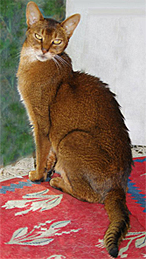This page has been archived and is being provided for reference purposes only. The page is no longer being updated, and therefore, links on the page may be invalid.
| Read the magazine story to find out more. |
|
|
Kitty Litter: Potential New Use for Spent Corn Grains
By Marcia Wood
November 22, 2013
Kitty litter that's nearly 100 percent biodegradable can be made by processing spent grains left over from corn ethanol production. U.S. Department of Agriculture (USDA) plant physiologist Steven F. Vaughn and his colleagues have shown that litter made with these grains as the starting material may prove to be more environmentally friendly than popular but nonbiodegradable clay-based litters. After use, clay litters mostly end up in landfills.
Spent grains are also known as DDGs, short for "dried distiller's grains." A DDGs-based litter may provide a new and perhaps higher-value market for the tons of DDGs that corn ethanol refineries now primarily market as a cattle feed ingredient.
In preliminary studies, Vaughn's group tested "x-DDGs." These are DDGs that, after being used for ethanol production, are treated with one or more solvents to extract any remaining, potentially useful natural compounds.
The team's laboratory experiments yielded a suggested formulation composed of the x-DDGs and three other compounds: glycerol, to prevent the litter from forming dust particles when poured or pawed; guar gum, to help the litter clump easily when wet; and a very small amount of copper sulfate, for odor control.
The resulting litter is highly absorbent, forms strong clumps that don't crumble when scooped from the litter box, and provides significant odor control, according to Vaughn. He's based at the Agricultural Research Service (ARS) National Center for Agricultural Utilization Research in Peoria, Ill. ARS is USDA's chief intramural scientific research agency.
The idea of using corn or other grains as the basis of an environmentally sound cat litter isn't new. But the Peoria team may be the first to extensively study the potential of x-DDGs as the primary component of a litter, and to make their results publicly available.
Their peer-reviewed scientific article about the litter appears in a 2012 issue of Industrial Crops and Products.
Vaughn did the work with ARS chemists Mark A. Berhow and Jill K. Winkler-Moser at Peoria, and Edward Lee of Summit Seed, Inc., in Manteno, Ill.
The kitty litter research is highlighted in the October 2013 issue of Agricultural Research magazine.

